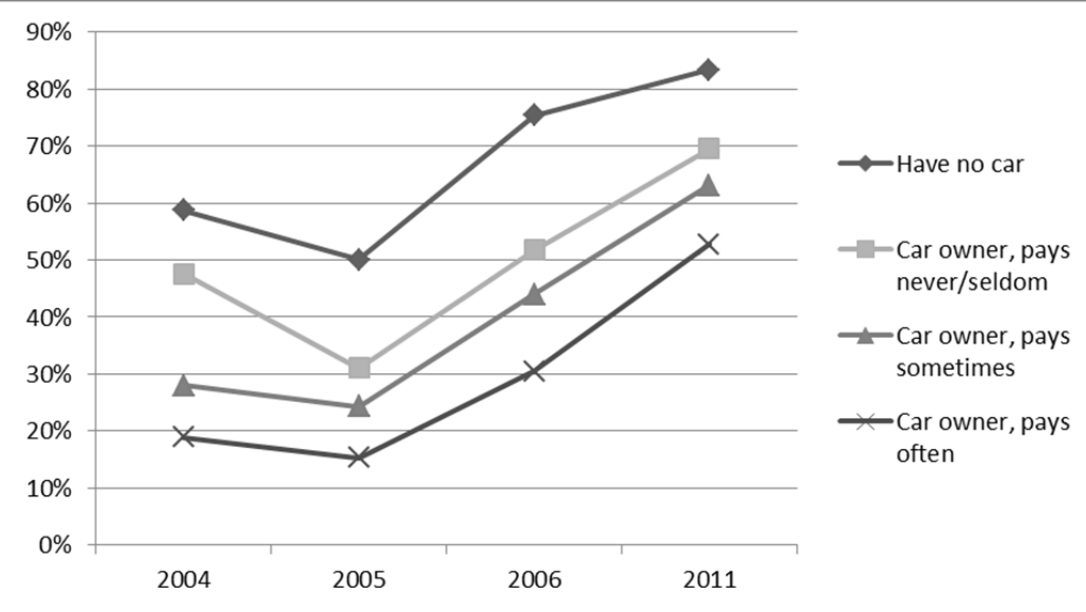
In the Zone: Stockholm’s congestion pricing system holds important lessons for Canada’s cities

Congestion pricing is gaining traction in Canadian cities. Following Mayor John Tory’s recommendation for tolls on two of Toronto’s major roads, let’s take this opportunity to look at congestion policies from around the world, with lessons and takeaways for Canada (drawing from our report on congestion pricing from last year). First up: Stockholm’s zone-based pricing system.
Stockholm Success Story
Congestion pricing in Stockholm has been around for over a decade, beginning with a seven-month trial in 2006. The objective was to improve mobility within the city’s centre by reducing traffic congestion. The policy created a cordon around the city’s core, charging vehicles entering or leaving the area through use of transponders and cameras. The city uses a dynamic pricing system, with charges varying from $1.50 to $3.00 (Canadian 2015 dollars) depending on the time of day (higher rates coincided with peak periods).
Stockholm’s congestion policy successfully reduced traffic congestion in the city core. Traffic levels decreased immediately after implementation following 15 years of steady, near-capacity usage rates. The number of vehicles crossing the cordon during the trial period fell by 20% to 30%, doubling the initial target of 10% to 15%.
Importantly, the city increased the capacity of their public transit system in parallel, and the combined effect boosted transit demand by 4% to 5% over an initial trial period. The congestion policy increased the cost of driving and decreased the relative cost of alternative forms of transport. These effects reinforced one another, increasing demand for public transit, and simultaneously allowing Stockholm to improve the quality and availability of service. The congestion charge also resulted in a 4% to 10% reduction in GHG emissions and a 7% to 9% reduction in air pollutants.
Show, don’t tell
As I noted above, Stockholm first implemented the congestion pricing policy as a temporary trial. Public support for Stockholm’s congestion policy was at its lowest right before the trial began: 34%. But support grew to 53% over 18 months, and Stockholmers ended up voting to keep the system permanently in a subsequent referendum. Even amongst drivers who were frequently tolled, more than 50% supported the system after it had been in place for a few years.

Following the trial, respondents noticed the benefits of the policy—more available parking, less congestion, and reduced air pollution—were noticeable, and had in fact exceeded their expectations. Respondents also indicated that the tolls themselves, and other issues like adapting to travel at off-peak times, were less problematic than anticipated. The success of the pilot project was essential to gaining public support.
Revenue generation was not the main goal of Stockholm’s congestion charge, but it played an important role in the success of the pilot project. Net revenues from Stockholm’s congestion policy were transparently earmarked as part of a comprehensive transport investment package, which included improvements to roads and public transit. Earmarking revenues for improving public transit ultimately helped improve the fairness of congestion pricing across socioeconomic groups. The net revenues were also integrated into a national investment plan, and gave local and regional governments a voice on how to invest. Transparent governance and clear spending priorities for the revenue proved to be a key point in gaining public support.
$2 to rub together
Does Stockholm hold any lessons for Toronto? We can think of two.
The experience in Stockholm suggests that Torontonians will need to see the benefits if they are to stay convinced. The shift in public approval in Stockholm came only after the policy was implemented, when drivers could see for themselves how congestion pricing could create faster and more reliable commute times – literally overnight. Toronto drivers will in turn experience shorter commute times, while the tolls they pay will allow the roads they use to be kept in better condition.
The same holds true for revenue. In addition to the toll-payers, citizens in Stockholm could see exactly where the revenue from the policy was going. Transparent governance, combined with measurable improvements in other services like public transit, proved crucial to gaining and holding public support. Tory has been clear on what the revenue will be spent on, and intends to set aside a portion of the revenues for public transit. The benefits of the policy can extend beyond decongestion, but in this case, seeing is believing.




Comments are closed.